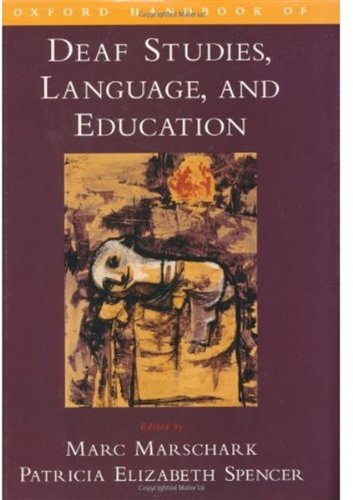

Most ebook files are in PDF format, so you can easily read them using various software such as Foxit Reader or directly on the Google Chrome browser.
Some ebook files are released by publishers in other formats such as .awz, .mobi, .epub, .fb2, etc. You may need to install specific software to read these formats on mobile/PC, such as Calibre.
Please read the tutorial at this link. https://ebooknice.com/page/post?id=faq
We offer FREE conversion to the popular formats you request; however, this may take some time. Therefore, right after payment, please email us, and we will try to provide the service as quickly as possible.
For some exceptional file formats or broken links (if any), please refrain from opening any disputes. Instead, email us first, and we will try to assist within a maximum of 6 hours.
EbookNice Team

Status:
Available0.0
0 reviews
ISBN 10: 0195149971
ISBN 13: 9780190241438
Author: Marc Marschark, Patricia Elizabeth Spencer
Language development, and the challenges it can present for individuals who are deaf or hard-of-hearing, have long been a focus of research, theory, and practice in D/deaf studies and deaf education. Over the past 150 years, but most especially near the end of the 20th and beginning of the 21st century, advances in the acquisition and development of language competencies and skills have been increasing rapidly. This volume addresses many of those accomplishments as well as remaining challenges and new questions that have arisen from multiple perspectives: theoretical, linguistic, social-emotional, neuro-biological, and socio-cultural. Contributors comprise an international group of prominent scholars and practitioners from a variety of academic and clinical backgrounds. The result is a volume that addresses, in detail, current knowledge, emerging questions, and innovative educational practice in a variety of contexts. The volume takes on topics such as discussion of the transformation of efforts to identify a "best" language approach (the "sign" versus "speech" debate) to a stronger focus on individual strengths, potentials, and choices for selecting and even combining approaches; the effects of language on other areas of development as well as effects from other domains on language itself; and how neurological, socio-cognitive, and linguistic bases of learning are leading to more specialized approaches to instruction that address the challenges that remain for deaf and hard-of-hearing individuals. This volume both complements and extends The Oxford Handbook of Deaf Studies and Deaf Education, Volumes 1 and 2, going further into the unique challenges and demands for deaf or hard-of-hearing individuals than any other text and providing not only compilations of what is known but setting the course for investigating what is still to be learned.
Part One Policies, Choices, and Foundations
1. It Seems Like Only Yesterday …
2. Foundations for Language Development in Deaf Children and the Consequences for Communication Choices
3. Rethinking Total Communication: Looking Back, Moving Forward
4. From Erasure to Recognition (and Back Again?): The Case of Flemish Sign Language
5. The Role of Language in Deaf and Hard-of-Hearing Children’s Social-Emotional Development
Part Two The Basics of Language and Language Development
6. Perception of the Prosodic Characteristics of Spoken Language by Individuals With Hearing Loss
7. The Fine Art of Conversation: The Pragmatic Skills of School-Aged Children With Hearing Loss
8. Grammatical Competence After Early Cochlear Implantation
9. Spoken Vocabulary Development in Deaf Children With and Without Cochlear Implants
10. Fingerspelling: Beyond Handshape Sequences
11. Vocabulary Acquisition in Deaf and Hard-of-Hearing Children: Research and Interventions
Part Three Multimodal and Multilingual Language Development
12. Bimodal Bilingualism: Sign Language and Spoken Language
13. Developing Sign Bilingualism in a Co-Enrollment School Environment: A Hong Kong Case Study
14. Acquisition of Sign Language as a Second Language
15. Teaching English as a Second Language to Deaf and Hard-of-Hearing Students
Part Four Neurological and Neurocognitive Bases of Language
16. A Biolinguistic Approach to Sign Languages
17. Neurocognitive Function in Deaf Children With Cochlear Implants: Early Development and Long-Term Outcomes
18. Neurolinguistic Studies of Sign Language Bilingualism
19. What the Illiterate Brain Tells the Deaf Brain
Part Five Challenges for Language Users and Language Researchers
20. New Directions in Signed Language Assessment
21. Investigating Sign Language Development, Delay, and Disorder in Deaf Children
22. Language and Communication in People Who Are Deafblind
23. Dyslexia and Deafness
Part Six Supporting Literacy and Learning
24. Cued Speech and Cochlear Implants: A Powerful Combination for Natural Spoken Language Acquisition and the Development of Reading
25. Encouraging Emergent Reading in Deaf and Hard-of-Hearing Children
26. Phonological Knowledge and the Development of Language and Literacy Skills in Deaf Learners
27. The Impact of Cochlear Implants on Deaf Children’s Literacy
28. Scaffolding Learning Through Classroom Talk: The Role of Translanguaging
29. Understanding Language in the Real World
the oxford handbook of deaf studies
the oxford handbook of deaf studies in language
the oxford handbook of deaf studies language and education
oxford handbook of music and disability studies
the oxford handbook of african american language
Tags: Professor of Old Testament Carol A Newsom, Deaf, Language